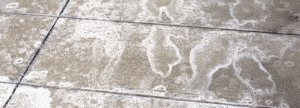Concrete walkways, driveways, and steps often face damage in the winter due to heavy salt use. Fortunately, there are some ways you can protect your concrete from cracking, helping it to wear better and last longer.

If conditions allow, the best way to protect decorative concrete from salt is not to use it at all. The best preventative steps you can take to protect your concrete are:
- Clear snow immediately so it doesn’t become packed down so you can limit salt use.
- Use sand for traction and avoid salt.
The next step step is to look into salt products and other melting or traction agents that are safe for your concrete, taking into account the typical weather conditions in your location as well as other concerns, like pet safety. There are many products available that offer a variety of solutions. Consumer Reports has a very helpful chart online here that shows pros and cons of various materials, including precautions for grass, plants, and pets or wildlife.
